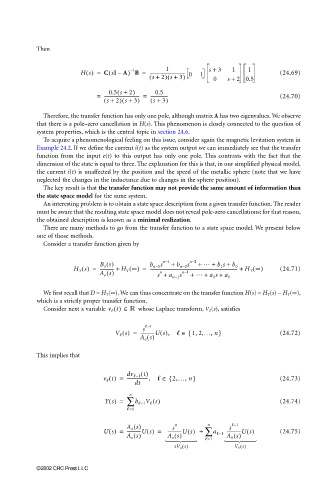Page 765 - The Mechatronics Handbook
P. 765
0066_Frame_C24 Page 13 Thursday, January 10, 2002 3:44 PM
Then
1
(
–
1
Hs() = C sIA) B = -------------------------------- s + 3 1 1 (24.69)
–
(
( s + 2) s + 3) 0 1 0 s + 2 0.5
0.5 s + 2) 0.5
(
= -------------------------------- = --------------- (24.70)
( s + 2) s + 3) ( s + 3)
(
Therefore, the transfer function has only one pole, although matrix A has two eigenvalues. We observe
that there is a pole–zero cancellation in H(s). This phenomenon is closely connected to the question of
system properties, which is the central topic in section 24.6.
To acquire a phenomenological feeling on this issue, consider again the magnetic levitation system in
Example 24.2. If we define the current i(t) as the system output we can immediately see that the transfer
function from the input e(t) to this output has only one pole. This contrasts with the fact that the
dimension of the state is equal to three. The explanation for this is that, in our simplified physical model,
the current i(t) is unaffected by the position and the speed of the metallic sphere (note that we have
neglected the changes in the inductance due to changes in the sphere position).
The key result is that the transfer function may not provide the same amount of information than
the state space model for the same system.
An interesting problem is to obtain a state space description from a given transfer function. The reader
must be aware that the resulting state space model does not reveal pole-zero cancellations; for that reason,
the obtained description is known as a minimal realization.
There are many methods to go from the transfer function to a state space model. We present below
one of those methods.
Consider a transfer function given by
B o s() b n−1 s n−1 + b n−2 s n−2 + … + b 1 s +
H T s() = ------------ + H T ∞() = ------------------------------------------------------------------------------- + H T ∞() (24.71)
b 0
A o s() s + a n−1 s n−1 + … + a 1 s + a 0
n
We first recall that D = H T (∞). We can thus concentrate on the transfer function H(s) = H T (s) − H T (∞),
which is a strictly proper transfer function.
Consider next a variable v t() ∈ whose Laplace transform, V (s), satisfies
−1
s
V s() = ------------Us(), ∈ { 1, 2,…, n} (24.72)
A o s()
This implies that
dv −1 t()
v t() = -------------------, ∈ { 2,…, n} (24.73)
dt
n
Ys() = ∑ b −1 V s() (24.74)
=1
A o s() s n n s −1
Us() = ------------Us() = ------------Us() + ∑ a −1 ------------Us() (24.75)
A o s() A o s() A 0 s()
=1
sV n s() V s()
©2002 CRC Press LLC

